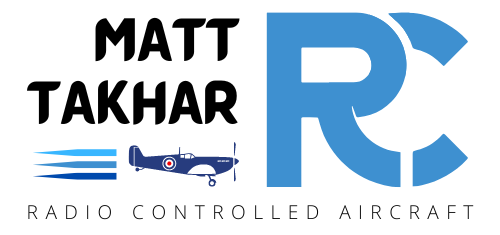As RC pilots, we’re always experimenting with our setups, tweaking and fine-tuning to suit the flying styles we pursue. For years, I’ve flown with Side Force Generators (SFGs) attached to my planes. They’ve been an essential part of my setup, especially for 3D flying, where they enhance stability and precision during high-alpha maneuvers. However, with my recent foray into IMAC (International Miniature Aerobatic Club) flying, I decided to try something new (recommended by Mark on Facebook): removing the SFGs. The results were surprising, and I learned a lot about how SFGs affect performance, depending on the style of flying.
What Are SFGs, and Why Are They Useful?
SFGs, or Side Force Generators, are vertical aerodynamic surfaces attached to a plane’s wingtips. Their main purpose is to improve performance in maneuvers like knife-edge flight, high-alpha maneuvers, and precision rolls. By reducing wingtip vortices and increasing side force, SFGs allow for greater stability, reduced adverse yaw, and better lift during knife-edge orientations.
For 3D pilots, SFGs are a game-changer. They make hovering easier, improve harrier performance, and allow for smoother, more controlled rolls. In short, they’re perfect for the dynamic, high-agility manoeuvres 3D flying demands. Although many 3D pilots don’t use them, this may be due to SFGs can slow down the roll speed and restrict other manoeuvres, it probably isn’t worth the trade off.
What Is IMAC, and How Does It Differ from 3D?
IMAC, or the International Miniature Aerobatic Club, is a precision aerobatic competition based on full-scale aerobatic flying. Pilots are judged on their ability to perform specific sequences of manoeuvres with accuracy and consistency. Unlike 3D flying, which emphasises freestyle and extreme agility, IMAC is about precision and control. Each maneuver must be flown smoothly, in a well-defined flight box, with minimal deviation from the intended path.
IMAC is challenging because it requires a completely different mindset and flying style. Instead of pushing your plane to its limits with wild manoeuvres, you’re focusing on making every roll, loop, and turn as precise as possible.
Flying Without SFGs: The IMAC Experience
When I started practicing the IMAC Sportsman 2025 schedule, it was recommended to remove the SFGs from my plane to see how it affected performance. Immediately, I noticed a difference. Without the SFGs, the plane felt lighter and more precise in rolls and loops. It tracked straighter through each maneuver, and transitions between elements felt smoother. This was a huge advantage in the IMAC sequence, where precision is the name of the game.
The absence of SFGs also reduced drag, making the plane feel faster and more responsive to throttle changes. This allowed for tighter loops and more consistent lines, which are critical in IMAC judging.
The Downside: Knife-Edge Maneuvers
While the plane performed better overall in the IMAC sequence, the lack of SFGs became apparent during a knife-edge loop attempt. Without the extra lift provided by the SFGs, I had to apply significantly more rudder to maintain the maneuver and pull out cleanly. This added workload made knife-edge flying feel more labor-intensive and less forgiving. I will admit when I attempted my first loop without SFGs I pulled out very close to the ground!
For IMAC, this isn’t a deal-breaker since knife-edge maneuvers are usually less exaggerated compared to 3D flying. However, it’s a good reminder that every setup has its trade-offs, and what works best depends on the style of flying you’re pursuing.
My Takeaways from Flying Without SFGs
Switching from 3D flying to IMAC has been an eye-opening experience, and removing the SFGs was a key part of adapting to this new challenge. Here’s what I’ve learned so far:
1. For IMAC:
Without SFGs, the plane tracks straighter, transitions more smoothly, and feels more responsive. These characteristics are invaluable for precision flying, making it easier to execute clean, consistent maneuvers in the IMAC schedule.
2. For 3D:
SFGs will help with high-alpha manoeuvres, hovering, harrier, and knife-edge tricks. However might not be worth the trade off on other manoeuvres, like riffle roll and harrier roll. SFGs would add extra drag.
3. Adjust Your Flying Style:
The absence of SFGs requires different control inputs, especially in knife-edge flight. It’s a trade-off between precision and lift, and you’ll need to adapt accordingly.
Conclusion: SFGs for Precision or Performance?
Flying with or without SFGs ultimately depends on what you’re trying to achieve. For IMAC pilots, removing SFGs can enhance precision and make your plane feel more agile and predictable. For 3D beginners, SFGs are an invaluable tool for stability and control during demanding manoeuvres.
If you’re like me and experimenting with both styles, I recommend trying both setups to see how they affect your flying. It’s a great way to learn more about your plane and expand your skills as a pilot.
If you’re interested in IMAC, check out my annotated Sportsman 2025 schedule here, and don’t forget to follow my progress on YouTube, where I document my journey into precision aerobatics!
Related Video:
Note: This is my very first flight trying IMAC Sportsman, I still had the SFGs on!
YouTube Playlist: Learning IMAC
Have you flown with or without SFGs? Let me know in the comments what worked best for you and why! Happy flying!
Discover more from Matt Takhar RC
Subscribe to get the latest posts sent to your email.








